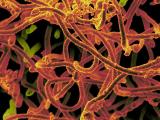Dec 6, 2007 (CIDRAP News) The number of people in Uganda suspected of being infected with a new strain of the Ebola hemorrhagic fever virus has grown to 93, and 22 have died, including four healthcare workers, according to news reports.
The outbreak was first reported on Nov 30 by the World Health Organization (WHO), which said a new subtype of the virus was found to be sickening people in Bundibugyo district in western Uganda. Four Ebola subtypes have previously been identified: Zaire, Sudan, Cote d'Ivoire, and Reston.
Uganda's health ministry said 58 cases have been confirmed in laboratory tests so far, Reuters reported today.
Dr Sam Zaramba, Uganda's director of health services, said one of the healthcare workers was a doctor who died in Kampala's Mulago Hospital after treating a patient in an isolation ward, the Reuters report said.
A report from the BBC today, citing other media reports, said the medical workers became infected with the Ebola virus because they lacked safety equipment. However, Zaramba told Reuters, "All medical staff dealing with Ebola have been issued with protective gear."
Some healthcare workers have threatened to strike unless they receive risk pay and adequate protective equipment, the BBC report said.
Health officials in Uganda say the new Ebola strain seems to have a low death rate when compared with other lethal Ebola strains, according to Reuters. The new strain has a 22%death rate compared with 50% to 90% for the other deadly strains.
However, Tom Ksiazek, MD, chief of the special pathogens branch at the US Centers for Disease Control and Prevention (CDC), said it's too early to say if the new Ebola strain in milder, the Associated Press (AP) reported yesterday.
Asiya Odugleh-Kolev, a W HO communications official who has worked on several Ebola outbreaks, said a milder Ebola strain might be problematic, because it could spread unnoticed and be confused with other diseases, the AP reported.
Patients have had some unusual initial symptoms, such as vomiting, with the new Ebola strain, WHO spokesperson Gregory Hartl said in a previous AP report. For the other known strains, initial symptoms include fever, headache, joint and muscle aches, sore throat, and weakness, followed by diarrhea, vomiting, and stomach pain, according to the CDC. Some patients have internal and external bleeding. There is no vaccine or specific treatment for the disease.
Meanwhile, members of parliament in Uganda today calledon the government to declare a state of emergency and quarantine areas affected by the Ebola outbreak, All Africa News reported today.
"We need to take radical measures if we are to save our people from this deadly virus," said Theodore Ssekikubo, who represents Rwemiyaga in Ssembabule district, during the parliament session today, according to the All Africa report.
Prime Minister Apollo Nsibambi told members of parliament that a state-of-emergency is an urgent matter that will be discussed at a cabinet meeting tomorrow, All Africa reported.
On Uganda's border with Kenya, health officials from Kenya are screening people entering the country, Dr James Nyikal, the country's head of medical services, told the BBC today.
See also:
Nov 30 CIDRAP News story "WHO reports new Ebola virus subtype in Uganda"
















